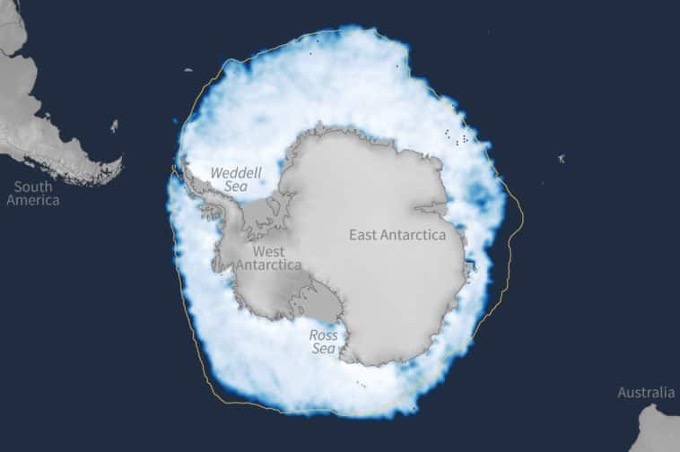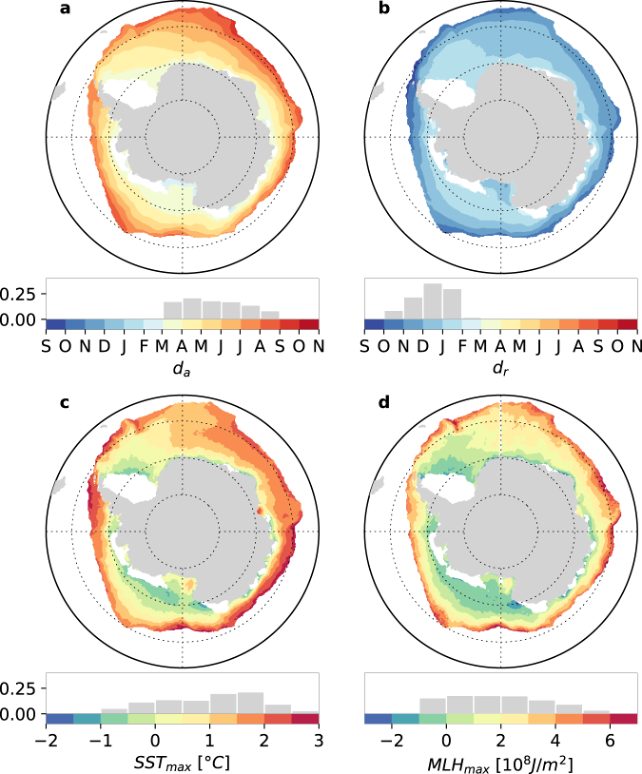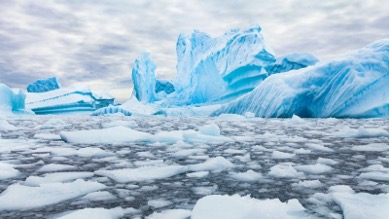A new study by French researchers at the Centre National de la Recherche Scientifique (CNRS) reveals a few secrets about the formation and evolution of the Antarctic ice pack. The dynamics of pack ice on a regional scale appear to influence the global climate and in turn affect ocean and atmospheric currents. A better understanding of these dynamics is essential if we are to understand climate change and meet current and future environmental challenges.
By Laurie Henry
The global impact of seasonal sea ice dynamics
Let’s start by recalling that pack ice is a floating layer of ice formed by the freezing of seawater in the polar regions, and let’s decipher its evolution through the seasons. Logically, in winter, the region’s icy climate favours the formation and expansion of ice. This period of intense cold allows the sea water to freeze, increasing the surface area of the ice pack. This winter expansion is not simply a localised phenomenon, as it has a significant impact on albedo, i.e. the ability of the Earth’s surface to reflect sunlight. In short, the larger the ice surface, the more sunlight is reflected back into space, helping to keep global temperatures down.
During the summer months, however, the situation is reversed. The higher temperatures cause the ice to melt, reducing the surface area of the pack ice. This melting process reduces the albedo, resulting in more solar heat being absorbed by the ocean.
This seasonal dynamic therefore influences not only the temperature of the water but also that of the surrounding air, affecting marine and atmospheric currents. On a global scale, numerical climate prediction models must therefore take precise account of the seasonal cycles of the Antarctic ice pack and transcribe as accurately as possible the conditions of its formation and evolution on a regional scale in order to achieve an accurate representation of the mechanisms of climate change and their long-term implications.
A fragmented ice pack
The very nature of pack ice is partly responsible for its changes over the seasons. Often perceived as a uniform expanse of ice, it is in fact a complex assembly of floating ice fragments. These fragments, known as “floes”, vary in size from small pieces to vast patches that can be several kilometres in diameter.
The way in which these floes interact with each other is fundamental to understanding the structure and dynamics of the pack ice. They are in constant motion, pushed and pulled by ocean currents, wind and interactions with other pieces of ice. When conditions are favourable, particularly in winter when temperatures fall, they can agglomerate to form a more uniform and continuous layer of ice.
The fragmented structure of the pack ice also has an impact on the local ecosystem. The spaces between the floes provide an essential habitat for marine wildlife, such as seals and penguins, which use these openings to breathe and access food.

Adélie penguins stand on the pack ice near a lead in the sea ice at Cape Royds. Photo by Peter Rejcek, NSF (2013)
But if the composition and fragmented structure of pack ice are at the heart of global climatic, ecological and oceanographic processes, what are the precise mechanisms responsible for its formation?
Two determining factors in the formation of ice pack
A recent study of the Antarctic ice pack by Kenza Himmich et al, 2023 and researchers from the Laboratoire d’Océanographie et du Climat at the CNRS highlights two key factors in the formation of the ice pack: the freezing of seawater and ice drift.
The first element, the freezing of the sea water, plays a crucial role in the structure of the ice pack. In fact, the welding between the ice floes in winter, mentioned above, is facilitated by the presence of this frozen water, known as “sea ice”, which acts as a natural cement.
The second factor, ice drift, refers to the movement of ice sheets under the influence of ocean currents and winds. This drift carries the ice from one region to another, modifying the distribution and thickness of the pack ice.
In some areas, such as the Weddell and Ross Seas, the convergence of ocean currents and favourable atmospheric conditions leads to an accumulation of ice, resulting in an early advance of pack ice. Conversely, to the west of the Antarctic Peninsula and in the Amundsen Sea, different conditions, such as warmer currents or unfavourable winds, can delay ice formation.

Geographic repartition of Antarctic regions © NOAA / National Snow and Ice Data Center
In addition, during the summer, the “uniform” structure of the pack ice can break up under the effect of rising temperatures, waves and currents. This fragmentation disrupts the melting of the pack ice, increasing the surface area to which the ice is exposed to warmer air and water, and thus accelerating the melting process. This separation of the floes also creates open channels of water, called “polynyas”, which facilitate the exchange of heat between the ocean and the atmosphere.

The maps show the dates of advance (da) and retreat (dr) of the pack ice, derived from satellite measurements. They also show the seasonal peaks in sea surface temperature (SSTmax) and the heat content of the mixed layer (MLHmax), based on satellite and in situ data © K. Himmich et al., 2023
Finally, the authors point out that the ocean layer in which the water is uniformly mixed (known as the mixing layer) plays a crucial role in the formation of Antarctic sea ice. For sea ice to form, it is essential for the temperature of this layer to be close to the freezing point of salt water, which is around -1.8°C (slightly lower than that of fresh water due to the salinity of sea water). This process is influenced by air temperature, solar radiation and ocean currents, affecting thermal regulation between the ocean and the atmosphere.
Regional variations in the advance of pack ice are essential for understanding climate change on the scale of the Antarctic continent. Their discovery will help scientists to accurately model future sea-ice trends and predict potential impacts on global climate.
Source : Himmich, K., Vancoppenolle, M., Madec, G. et al. Drivers of Antarctic sea ice advance. Nat Commun 14, 6219 (2023). https://doi.org/10.1038/s41467-023-41962-8
